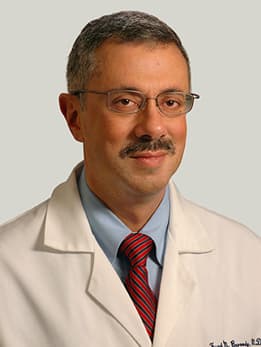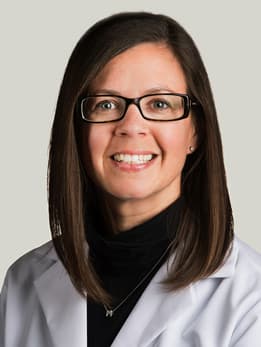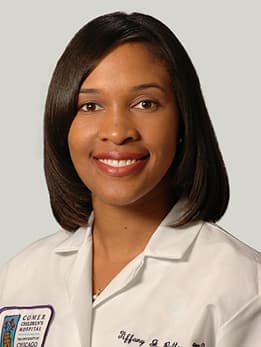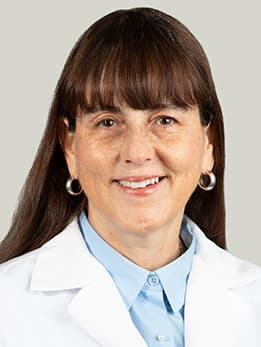Aerodigestive Conditions in Children
Aerodigestive conditions in children are often complex because they involve the upper airway, lungs and upper digestive tract and can affect swallowing and sleeping. Our experts at the Pediatric Aerodigestive Clinic are dedicated to understanding the cause of your child’s condition and providing your family with a personalized treatment plan. Treatment requires a thorough evaluation from multiple specialty doctors. Our team is made up of every specialty your child will need — including gastroenterologists, otolaryngologists, pulmonologists, surgeons and speech therapists.
Contact our team at 773-834-4106
What to Expect
We want to make it easy for your child to see our specialists and receive collaborative care. Our team approach ensures your child will have appointments with all our specialists in one visit. Our first step is to evaluate your child’s condition through a series of diagnostic tests. There are many different types of airway disorders and gastrointestinal diseases, which is why an accurate diagnosis is important. We’ll test things like breathing and swallowing muscles and breathing patterns while your child sleeps.
Treatment
Although your child’s treatment will depend on the diagnosis, our physicians have expertise in the most advanced and innovative techniques. We offer surgical and non-surgical treatments, including state-of-the-art endoscopic and minimally invasive procedures.
- Flexible fiberoptic laryngoscopy
- Flexible fiberoptic bronchoscopy
- Video swallow study (oral-pharyngeal motility study)
- FEES (fiberoptic endoscopic evaluation of swallowing)
- Pulmonary function testing pH studies
- Esophageal manometry
- Sleep studies
- Surgery
- Upper gastrointestinal endoscopy
Additionally, physicians from various specialties work together to develop a treatment plan to ensure your child receives the most comprehensive care possible.
Contact Us
Conditions & Treatments
Gastroesophageal reflux (GERD) is a chronic symptom of mucosal damage caused by stomach acid coming up from the stomach into the esophagus. Symptoms include a burning sensation in the chest, chest pain, difficulty swallowing, dry cough, hoarseness or a sore throat, regurgitation of food or sour liquid (acid reflux) or a sensation of a lump in the throat.
GERD is diagnosed with several tests including: a monitor to check the amount of acid in your esophagus, an X-ray of your upper digestive system, an endoscopy and a test to measure the movement of the esophagus.
Possible treatments include antacids that neutralize stomach acid, medications that reduce acid production, medications that block acid production and heal the esophagus, surgery to reinforce the lower esophageal sphincter (nissen fundoplication) and surgery to strengthen the lower esophageal sphincter (linx).
ENT Problems from GERD
An increasing number of children are being diagnosed with gastroesophageal reflux disease (GERD). GERD can cause a variety of ear nose and throat problems. Awareness of the role of GERD in these conditions is the key to successful treatment. At the University of Chicago Medicine Comer Children's Hospital, pediatric otolaryngologists work with pediatric gastroenterologists and pediatric surgeons to provide a comprehensive, multidisciplinary approach to managing GERD.
Vocal cord paralysis occurs when one or both the vocal cords are not moving. This can be due to injury to the vocal cords during surgery; intubation; neck or chest trauma; tumors in skull base, neck or chest; and viral infections.
Children may experience vocal changes, airway problems and/or swallowing issues. With vocal changes, they may complain of hoarseness or a breathy voice. With respect to airway problems, they often complain of shortness of breath and noisy breathing. They may also choke on foods or liquids due to the paralysis.
An otolaryngologist will diagnose a child by performing a flexible laryngoscopy. Oftentimes, further testing is required to find the cause for the paralysis. Depending on the type of paralysis, children can be treated in a variety of options, ranging from voice therapy to phonosurgery.
A laryngeal cleft is an abnormal connection between the trachea (windpipe) and the esophagus (food pipe). Some children are born with clefts and symptoms include coughing, choking, shortness of breath, sleep apnea, recurrent respiratory infections, aspiration and hoarseness. To diagnose this condition, a physician will look at the airway when the child is asleep.
Treatment depends on the severity of the laryngeal cleft; a mild cleft may only require monitoring, but deeper clefts require surgery.
A tracheostomy is a tube into the airway from the neck that allows patients to breath. Children may require a tracheostomy to help with cleaning out their airways, bypass a site of obstruction, or if they require a machine to help them breath.
Our team can help continue to monitor the airway and manage any issues that arise with the tracheostomy.
Airway stenosis refers to narrowing of the larynx (voice box) or trachea (windpipe). Children can be born with this narrowing or may have developed it from being intubated. Symptoms include noisy breathing, wheezing, hoarseness, shortness of breath and respiratory distress.
Typically, airway stenosis is diagnosed with a thorough evaluation of the airway, such as a laryngoscopy and bronchoscopy. Depending on the severity, the treatment can range from monitoring the patient, endoscopic surgery or open reconstruction of the airway.
Tracheomalacia is the collapse of the airway while a person is exhaling. Children can be born with it or acquire it later in life. Symptoms include a high pitched or noisy breathing, frequent coughing and frequent airway infections. In very severe cases, patients may experience choking with feeding as well as apneic and blue spells (cyanosis).
To diagnose tracheomalacia, physicians perform a bronchoscopy (airway evaluation) to see if there is collapse of the child’s airway during breathing. Depending on severity, treatment may or may not be required. Children can grow out of the condition if it is mild. In more severe cases, they may require positive pressure or more extensive surgery.
Laryngomalacia is the most common birth defect of the larynx. It occurs when the tissue above the voice box collapses. Symptoms include noisy breathing, poor weight gain, spitting up, choking on foods, retractions and apnea (stops breathing).
Evaluation starts with a thorough history and physical, and the diagnosis is confirmed with a flexible laryngoscopy to look at the airway.
A majority of patients will grow out of the condition on their own after 12 to 18 months and may require only medications to control their reflux. Patients who fail to thrive, stop breathing at night or have blue spells (cyanosis) will require a surgical procedure to help their condition.
Aspiration occurs when food or drink enter the airway. In children, it is often first identified as a choking episode after which they often develop a chronic cough. Children can also have hoarseness, drooling, failure to thrive and chronic respiratory illness. Some common causes of aspiration include reflux, anatomical abnormalities as well as neurological conditions.
Esophageal atresia is when the upper part of the esophagus does not connect with the lower esophagus and stomach. Symptoms include coughing, gagging, drooling, poor feeding or choking/bluish coloration to the skin with attempted feedings (cyanosis).
Before birth, an ultrasound performed on the pregnant mother may show too much amniotic fluid, which can be a sign of esophageal atresia or other blockage of the digestive tract. However, the disorder is usually detected shortly after birth when feeding is attempted and the infant coughs, chokes and turns blue.
As soon as the diagnosis is suspected, a physician will attempt to pass a small feeding tube through the child’s mouth or nose into the stomach. The feeding tube will not be able to pass all the way to the stomach in a baby with esophageal atresia. An X-ray of the esophagus will show an air-filled pouch and air in the stomach and intestine. If a feeding tube has been inserted, it will appear coiled up in the upper esophagus. Surgery to repair the esophagus should be done quickly after the baby is stabilized so that the lungs are not damaged and the baby can be fed.
Tracheoesophageal fistula is an abnormal connection between the upper part of the esophagus and the trachea or windpipe. Symptoms include frothy, white bubbles in the mouth, coughing or choking when feeding, vomiting, bluish skin color when feeding, difficulty breathing and a very round, full abdomen.
Before birth, an ultrasound performed on the pregnant mother may show too much amniotic fluid, which can be a sign of esophageal atresia or other blockage of the digestive tract.
The disorder is usually detected shortly after birth when feeding is attempted and the infant coughs, chokes and turns blue. As soon as the diagnosis is suspected, an attempt to pass a small feeding tube through the mouth or nose into the stomach should be made by a health care professional. The feeding tube will not be able to pass all the way to the stomach in a baby with esophageal atresia.
An X-ray of the esophagus shows an air-filled pouch and air in the stomach and intestine. If a feeding tube has been inserted, it will appear coiled up in the upper esophagus.
Surgery to repair the esophagus should be done quickly after the baby is stabilized so that the lungs are not damaged and the baby can be fed. Before the surgery, the baby is not fed by mouth. Care is taken to prevent the baby from breathing secretions into the lungs.
Eosinophilic esophagitis occurs when a type of white blood cell called eosinophil builds up in the esophagus and inflames or injures the esophageal tissue. This is typically a reaction to foods, allergens or acid reflux. Damaged esophageal tissue can lead to difficulty swallowing or cause food to get caught when swallowing.
Symptoms include difficulty feeding or swallowing, vomiting, abdominal pain, food impaction, poor growth, malnutrition, weight loss or no response to GERD medication.
To diagnose eosinophilic esophagitis, a gastroenterologist will perform a biopsy of the esophagus. The child is sedated and the physician inserts an endoscope into the mouth and through the esophagus, stomach and upper part of the small intestine, where a small sample of tissue is taken.
The main treatments for eosinophilic esophagitis are dietary therapy, medication and dilation.
An esophageal stricture is a condition in which scar tissue narrows the diameter of the esophagus.
Symptoms include difficulty swallowing, feeling that food is not passing into the stomach, painful swallowing, unintended weight loss, heartburn and the regurgitation of food or liquids.
A barium swallow test, upper endoscopy and esophageal pH monitoring are all used to diagnose an esophageal stricture. Treatment options include esophageal dilation, esophageal stent placement or esophageal surgery.
A hiatal hernia is where the stomach bulges up into the chest through an opening in the diaphragm (the hiatus). It can be diagnosed with an endoscopy or with specialized X-ray (using a barium swallow) that allows a doctor to see the esophagus.
If the hiatal hernia is in danger of becoming constricted or strangulated, surgery may be needed to reduce the hernia and put it back where it belongs.
Children with achalasia will often have trouble swallowing or feel like food is stuck in the esophagus. To diagnose achalasia, doctors use an esophageal manometry, X-ray or endoscopy. Possible treatments for achalasia include oral medications, dilation and/or esophagomyotomy.
Genetic abnormalities
Cystic fibrosis
Apnea/obstructive sleep apnea
Asthma
Breathing problems with concerns for gastroesophageal reflux or aspiration
Bronchiectasis
Bronchomalacia
Bronchopulmonary dysplasia
Chronic cough
Chronic lung disease
Noisy breathing (stridor)
Recurrent pneumonia
Aerodigestive Specialists
Patient Information
Your care and well-being are our primary concerns, and we want your stay to be as comfortable as possible.
Directions & Maps
We are here to help you find the best way to navigate to our locations. We offer step-by-step directions from every direction.
Second Opinions
Seeking the opinion of an expert can ease your mind and help you feel more secure in the medical decisions you are making.
Clinical Trials
Our research gives our patients access to new treatments and therapies.
Classes & Events
We offer relevant classes, screenings and support groups to help you lead a healthier life.




